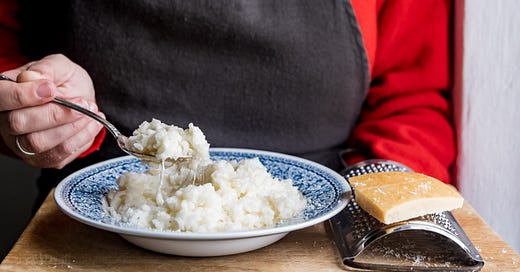Mangiare in bianco
This white rice with butter, Parmigiano Reggiano, and mozzarella sits right in between comfort food and a cure-all dish
My mum didn’t teach me how to cook, that was grandma. What my mum taught me, though, is how to nurture people.
If I had had a bad day, if I was cold – and that would happen quite often in a country house in the winter -, if I had a stomach ache, she would always say:
Stasera ti faccio un risino bianco, vedrai passa tutto.
Tonight, I’ll cook you some white rice, you’ll see that everything will pass.
Her risino bianco was nothing more than white rice, boiled and drained, then dressed with a knob of butter and a spoonful of grated Parmigiano Reggiano. A bit of rice cooking water, rich in starch, would make it creamy and fix your stomach, turning the rice into a hug from the inside.
And, when it was just a matter of bad mood, some torn mozzarella would be thrown into the rice, turning it into a quick meal, perfect for rainy days, busy days, or, actually, any day.
Mangiare in bianco
That was the closest we came to mangiare in bianco.
When you are not feeling well, your stomach is upset, or if you overate for too many days in a row, the folk wisdom suggests eating in bianco, that is favouring white food. In the Italian culture, eating white means eating healthily, avoiding foods that are difficult to digest, high in fat or sugar. The first thing that comes to mind is eating unseasoned white rice with just a drizzle of extra virgin olive oil. This belief has a long history, as unseasoned white rice was served to sick people as their only meal since the XIII century.
Along with unseasoned white rice, we usually consider food apt to mangiare in bianco steamed fish, boiled chicken and potatoes, cooked apples, and bananas.
So you can easily understand that there is no space for other white food such as cream, bechamel, butter, and other white, rich, heavy foods.
You’ll be happy to know that this is often ignored, and the proof is my mum’s white rice.
Whenever I think about mangiare in bianco, my mind runs to my friend Benedetta Gargano, her nonna, and her book L’invenzione della felicità, a novel inspired by her relationship with her nonna, and the time her grandma spent with her, when Benedetta adopted her not to let her spend the last years of her long, exciting life in a nursing home. Benedetta gave her 97-year-old grandma the chance to learn, be surprised, and have fun when she thought her life was almost over, and she was gifted in return with the biggest, purest love. Her nonna was witty, fun, and had a great appetite for life. This is one of the skirmishes I loved more from the book1:
-Nonna, oggi sto a casa e posso cucinare. Hai qualche desiderio particolare per pranzo?
-Non lo so, per la verità vorrei mangiare in bianco.
-Ok. Pastina all'olio e merluzzo bollito?
-Per carità! Il merluzzo mi rimane sullo stomaco!
-Va bene. Allora riso pilaf e zucchine al vapore?
-Madonna mia, che tristezza!
-Senti, facciamo prima se mi dici cosa vuoi.
-Il cavolfiore al grattè.
-Caspita! E tu questo lo chiami mangiare in bianco?
-Bennussi', tu trovami un'antecchia di colore nel cavolo al grattè e io ti giuro che ti do un guiderdone!
And now, quickly and freely translated in English for you.
-Grandma, I'm home today and I have time to cook. Do you have any special wishes for lunch?
-I don't know, I really want to eat in bianco, plain.
-Okay, then. Some pastina with olive oil and boiled cod?
-No way! Cod stays is difficult to digest for me!
-That's fine. Then rice pilaf and steamed zucchini?
-Madonna mia, how sad!
-Listen, it's quicker if you tell me what you want.
-Cauliflower au gratin.
-Wow! Do you call this a white meal?
-Bennussi', find me a spot of colour in the cauliflower au gratin and I swear I'll give you a reward!



